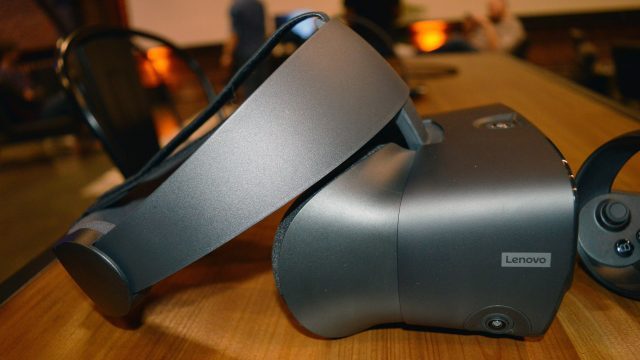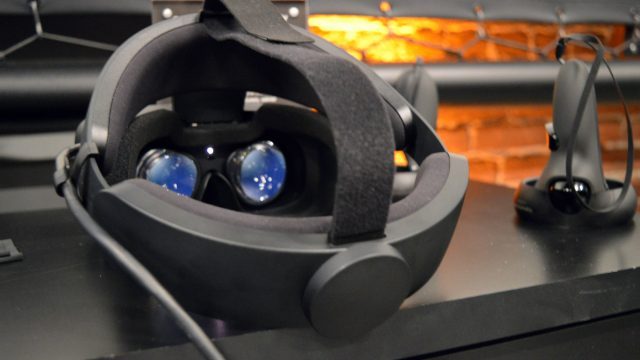Ergonomics

The Rift S looks like a totally new headset from the outside, and actually a bit bulkier and uglier than its predecessor in my opinion. Granted, I’ve always said that it doesn’t matter how a headset looks like on the outside as long as it offers a good experience inside, so I’m not going to complain much about looks.
An Unlikely Ally

What does matter though is how it fits and feels. Oculus says they partnered with Lenovo to collaborate on the design and manufacture of the Rift, and that’s led to an ergonomic approach which looks a lot like Lenovo’s prior VR headsets. Rift S now uses a halo style headband but retains the overhead strap of the original Rift.
The combination feels very, very comfortable on my head, but the comfort of halo head mounts seems anecdotally to be hit or miss depending on the shape of the user’s head. The top strap ought to help accommodate a wider range of heads though, because it offers a reasonable way to distribute some additional weight and adjust the height of the lenses as they hang in front of the user’s eyes. Lenovo’s Daydream headset, which is somewhat similar in design to Rift S, lacks an overhead strap and suffers ergonomically because of it.

The new approach has a two points of adjustment (a knob on the back of the band for adjusting tightness and the velcro strap on top) rather than the three of the original Rift, which makes it quick and easy to adjust. There’s also a way now to adjust the headset’s eye-to-lens distance which can help maximize field of view and make the headset easier to use with glasses. To adjust, just press the button on the bottom of the visor and slide the entire assembly forward and back (very similar to PSVR and Vive Pro).
I’ll need longer sessions in Rift S to suss out any potential ergonomic pain points, but (in 30 minute sessions at least) the headset feels comfortable, better balanced than its predecessor, and highly adjustable.
Hidden Audio
Missing from the Rift S is the headphones of the original Rift, but on-board audio hasn’t been removed it’s just been hidden. Similar to Go and Quest, Oculus has hidden openings in the Rift S headband near the user’s ears from which audio emanates. This arguably makes the headset easier to put on (by getting the headphones out of the way and removing the need to adjust their position), but comes at the expense of some audio fidelity and noise isolation that prevents real world noise from distracting from virtual noise.
Granted, the Rift S has a 3.5mm jack on the side, so you can use your own headphones if you want, but I didn’t personally feel like the original Rift’s headphones were problematic and quite liked the quality and noise isolation they provided without needing to manage a separate pair of headphones which weren’t designed to fit around the head straps. Indeed, even the headphones Oculus provided during my Rift S demo had a cumbersome fit around the headset’s straps. In-ear earbuds then could be a good way to go, but add even more friction than the original Rift’s integrated headphones.
As for audio quality and positionality, the demo environment was far too loud to get a good sense from the hidden audio in Rift S, so I’ll need to look into this more carefully in another session.
A Touch Different

Rift S uses controllers which are similar to the original Rift’s excellent Touch controllers, but not exactly the same (they’re identical to those used on Quest). The most obvious difference is that the tracking rings now go over the hand instead of under (which better positions them to be seen by the cameras on the headset). The less obvious differences are a slightly different feel to the sticks and buttons, and subtle change to the controller’s shape.
That subtle change doesn’t look like much when you see the controllers side-by-side, but it feels—to my hands at least—like a step back from ‘perfect’. While the original Touch controllers fit beautifully in my hands, the Rift S controllers just don’t feel quite as good. This is likely to vary from person to person, but the slightly straighter feeling controller doesn’t cup the form of my hand as well. It’s not a drastic change mind you, but it’s notable considering how damn good the original Touch controllers feel.
While the buttons feel a bit different from the original controller, they are fine overall. The sticks on the other hand feel ever so slightly smaller or less robust, including the ‘down click’ function which doesn’t offer as much feedback. These are still engineering samples however, so hopefully there’s a bit more tuning to come to the stick feel.
– – — – –
All-in-all, Rift S is shaping up to be a better offering at a similar price as what came before it, but it doesn’t feel indicative of three years and ostensibly millions of dollars of R&D since the launch of the first Rift. Backed by Oculus’ impressive content library, it’s likely to be a strong offering for new users, but early adopters of the Rift might miss some features of the original.
There’s a lot to talk about with Rift S and we surely haven’t covered everything with this hands-on. Let us know your questions below!






